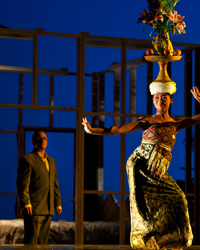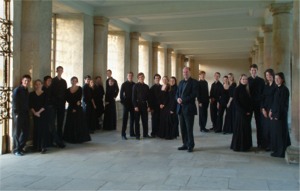 I had the privilege of catching an hour or so of mezzo-soprano Stephanie Blythe’s masterclass at the San Francisco Conservatory of Music yesterday in between meetings and deadlines. Not only is Blythe one of the most versatile and stunning singers of today, but it also turns out that she’s a wonderful pedagogue with a lovely sense of humor.
I had the privilege of catching an hour or so of mezzo-soprano Stephanie Blythe’s masterclass at the San Francisco Conservatory of Music yesterday in between meetings and deadlines. Not only is Blythe one of the most versatile and stunning singers of today, but it also turns out that she’s a wonderful pedagogue with a lovely sense of humor.
I watched Blythe coach three of the Conservatory’s young female singers. The two sopranos sang arias from Italian operas (Verdi’s Rigoletto and Bellini’s I Capuleti ed i Montecchi); the mezzo performed a Mahler art song.
Blythe has an immediate way of connecting with students. She corrected the shoulder-rolling posture of one of the sopranos by talking about the TV show Dancing with the Stars. “I’m addicted to Dancing with the Stars,” declared Blythe, before launching into a cautionary tale about the problems of wearing revealing clothing when your posture isn’t perfect. (The soprano in question had hunched, forward-rolling shoulders which were made all the more obvious by the fact that she was wearing a strapless black cocktail dress.) “When you sing, you lead with your sternum,” Blythe instructed, flowing across the stage in a voluminous black and white floral kimono, black slacks and opened-toed sandals. “My teacher used to say to me, ‘you’ve got big tits; stick ’em out and sing.'”
Besides discovering that Blythe is addicted to trashy TV (she’s also a fan of America’s Next Top Model) I also learned so much about the art of singing in that short hour. Here are some more of Blythe’s pedagogical pointers:
1. Stand in a three-quarter stance rather than face-on to the audience. In this stance you are balanced and no one can push you over. Plus the angle is flattering.
2. Let your hands go. Don’t hold them in front of you like you’re carrying a loaf of bread.
3. The motion of the sound should always move forward even in quiet passages. Always spin the tone.
4. For every aria you sing, you should sing five art songs. Although it’s not possible to make a career singing art song full time, art song is the best way of training the voice and developing communication / acting skills.
5. You don’t have to stand stock still by the piano when you give a recital.
6. Acting is connecting to a thought. Follow your instincts, commit to a thought, and move with purpose and direction.

 As I walked out of the press screening of Richard Linklater’s excellent new film about Orson Welles and the build-up to his landmark 1937 Mercury Theatre adaptation of Shakespeare’s Julius Caesar last night, it struck me that as engrossing as Linklater’s film is — and it is indeed worth seeing for the quality of the performances, the slick storytelling and the shabbily endearing 1930s New York aesthetic — in one respect it’s just like pretty much all of the films that are made these days about the world of the stage: It paints it in a twee and comedic light.
As I walked out of the press screening of Richard Linklater’s excellent new film about Orson Welles and the build-up to his landmark 1937 Mercury Theatre adaptation of Shakespeare’s Julius Caesar last night, it struck me that as engrossing as Linklater’s film is — and it is indeed worth seeing for the quality of the performances, the slick storytelling and the shabbily endearing 1930s New York aesthetic — in one respect it’s just like pretty much all of the films that are made these days about the world of the stage: It paints it in a twee and comedic light.









